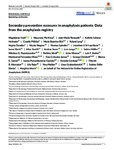Secondary prevention measures in anaphylaxis patients: Data from the anaphylaxis registry
Kraft, Magdalena
Knop, Macarena Pia
Renaudin, Jean-Marie
Scherer Hofmeier, Kathrin
Pföhler, Claudia
Bilò, Maria Beatrice
Lang, Roland
Treudler, Regina
Wagner, Nicola
Spindler, Thomas
O'B Hourihane, Jonathan
Maris, Ioana
Koehli, Alice
Bauer, Andrea
Lange, Lars
Müller, Sabine
Papadopoulos, Nikolaos G.
Wedi, Bettina
Moeser, Anne
Ensina, Luis F.
Fernandez-Rivas, Montserrat
Cichocka-Jarosz, Ewa
Christoff, George
Garcia, Blanca E.
Poziomkowska-Gęsicka, Iwona
Cardona, Victoria
Mustakov, Tihomir B.
Rabe, Uta
Mahler, Vera
Grabenhenrich, Linus
Dölle-Bierke, Sabine
Worm, Margitta
The Network for Online Registration of Anaphylaxis (NORA)
Background
Patients with a history of anaphylaxis are at risk of future anaphylactic reactions. Thus, secondary prevention measures are recommended for these patients to prevent or attenuate the next reaction.
Methods
Data from the Anaphylaxis Registry were analyzed to identify secondary prevention measures offered to patients who experienced anaphylaxis. Our analysis included 7788 cases from 10 European countries and Brazil.
Results
The secondary prevention measures offered varied across the elicitors. A remarkable discrepancy was observed between prevention measures offered in specialized allergy centers (84% of patients were prescribed adrenaline autoinjectors following EAACI guidelines) and outside the centers: Here, EAACI guideline adherence was only 37%. In the multivariate analysis, the elicitor of the reaction, age of the patient, mastocytosis as comorbidity, severity of the reaction, and reimbursement/availability of the autoinjector influence physician's decision to prescribe one.
Conclusions
Based on the low implementation of guidelines concerning secondary prevention measures outside of specialized allergy centers, our findings highlight the importance of these specialized centers and the requirement of better education for primary healthcare and emergency physicians.
Files in this item

